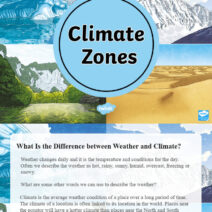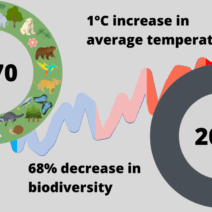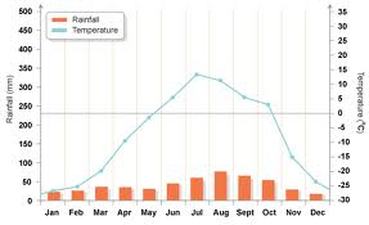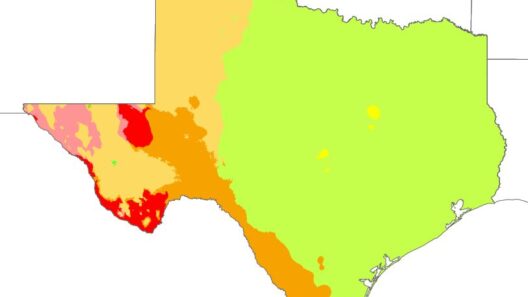The Earth is a magnificent tapestry, intricately woven with diverse climates that dictate the rhythm of life across continents. Understanding the three predominant climate zones is akin to deciphering the threads of this grand design. Each zone—tropical, temperate, and polar—offers a unique narrative about our planet’s climate and ecosystems. This guide elucidates these zones, positioning students as stewards of knowledge in the realm of climate science.
Tropical Climate Zone
Imagine stepping into a vibrant, verdant jungle. The air is thick, teeming with the scents of blooming flora and the sounds of exotic fauna. This is the tropical climate zone. Characterized by its warmth, it lies near the equator, where the sun’s rays strike directly, creating an enduring summer. This zone is defined by its minimal temperature variation, with average temperatures ranging from 20°C to 30°C (68°F to 86°F) year-round.
The tropical climate thrives in two principal types: tropical rainforest and tropical savanna. Tropical rainforests are the emerald hearts of our planet. These lush biomes boast an astounding biodiversity, hosting more than half of the Earth’s plant and animal species. Continuous rains nourish towering trees, broadleaved plants, and an understorey rich in life. In contrast, tropical savannas reveal the interplay of seasons. With a distinct wet and dry period, these grasslands are punctuated by acacia trees, and they play host to a rich array of herbivores, from elephants to gazelles, all adapted to the rhythm of droughts and deluges.
Temperate Climate Zone
Venturing away from the tropics leads us to temperate climate zones—where a delicate balance between warmth and chill sets the stage for seasonal transformation. Picture a cool, crisp autumn day, leaves swirling like confetti, heralding the onset of winter. The temperate zone experiences four distinct seasons: spring, summer, autumn, and winter, each with its own palette of colors, moods, and ecological dynamics. Average temperatures can range from -30°C in winter to over 30°C in summer, demonstrating the zone’s dynamic character.
This zone is subdivided into several climates, including oceanic, humid continental, and Mediterranean. The oceanic climate—often characterized by its moderate temperatures and abundant precipitation—fringes coastlines and nurtures lush, green landscapes. In contrast, the humid continental climate, marked by its extremes, witnesses sweltering summers and frigid winters, fostering a rich tapestry of deciduous and coniferous forests. Meanwhile, the Mediterranean climate conjures images of sun-soaked summers and mild, rainy winters, frequently found along the coasts of Southern California and the Mediterranean Sea. This climate supports diverse agriculture, producing some of the world’s most cherished foods, like olives and grapes.
Polar Climate Zone
As one journeys further from the equator, the landscape transitions into the stark but beautiful polar climate zones, where the sunlight trembles delicately against icy expanses. These regions, encased in perpetual frost, are perhaps the most enigmatic on the planet. Polar climates are characterized by chilling temperatures, often plunging below -30°C (-22°F). They subsist in two principal forms: tundra and ice cap.
The tundra, characterized by its treeless plains, is an astonishing realm where the ground is frozen, known as permafrost, inhibiting the growth of trees. Yet, in this austere environment, resilient life sparsely exists—mosses, lichens, and hardy wildflowers bloom bravely during the brief summer thaw. The tundra community reveals an extraordinary spectacle during the migratory season, as various species traverse the land, contributing to a dynamic ecosystem.
Conversely, the ice cap climate blankets the Arctic and Antarctic regions, where icebergs float like colossal sculptures against a starkly blue horizon. The overwhelming cold leaves little room for life. Nevertheless, polar bears, seals, and a myriad of seabirds have adapted to this unforgiving environment, illustrating nature’s adaptability and resilience.
Conclusion
Understanding the three climate zones is not merely an academic exercise; it is an essential key to comprehending our terrestrial home. Each zone houses unique ecosystems that interact dynamically, forming a delicate web of life. Students learning about these climates are not only gaining knowledge but also empowering themselves to become advocates for environmental stewardship. In a world grappling with climate change, the insights gleaned from understanding tropical, temperate, and polar climates are crucial for envisioning sustainable paths forward.
This knowledge equips the next generation with the tools to champion the health of our planet. Through education, awareness, and proactive engagement, students can emerge as informed citizens, passionate about nurturing the Earth and its diverse climates. Each climate zone is a chapter in the Earth’s story, and it is imperative that we understand and protect them for generations to come.








